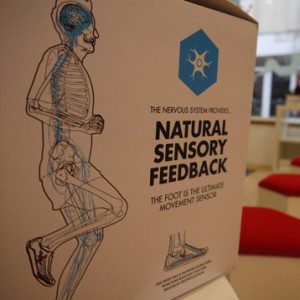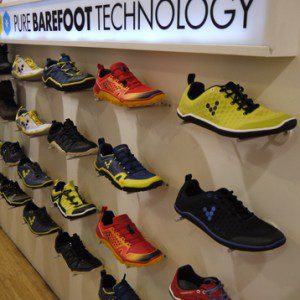“I don’t like the term barefoot running,” says Peter Ford, Vivo Barefoot’s running coach and a sub-2:40 marathon runner. “What we’re talking about here is skilled running.”
I’m here at Vivo Barefoot’s flagship store in Covent Garden to learn more about what they mean by “skilled running”.
As runners, it’s all too easy to forget about the importance of technique. We’re happy to put the miles in, to chuck in a bit of speed work, maybe even a few hills. But how many of us really take time to hone our technique?
Yet it’s a huge part of running well and staying injury-free. According to Ford, good running is based around three principles: posture, rhythm and relaxation.
The workshop begins with Ford filming me running on a treadmill. After some video analysis, it’s clear that I’m not letting my right heel fully engage with the floor – a small issue over short distances, but something that could play havoc over a marathon.
I’m heartened, however, when Ford says he’s seen runners in a lot worse state than me. And he’s not just talking about heel strikers here. There’s a new breed of runner who’s just as injury-prone: the one who’s read Born to Run, cast aside their trainers and believes they’re now running like a Tarahumara Indian.
In fact, Christopher McDougall, the author of that book, sought advice from Vivo Barefoot’s Lee Saxby when he returned from the Copper Canyons with his own injury.
Posture, rhythm, relaxation
The modern world, and sit-down jobs in particular, play havoc with our posture. If your sat hunched over a desk all day, it’s unsurprising that you’ll take some of those bad habits with you to your running. Ford encourages an upright posture with shoulders back, eyes looking forward and a neutral pelvis. To encourage a better posture, a set of deep squats is prescribed.
Rhythm is also crucial, and that requires a quick cadence – the amount of steps taken per minute. Ford recommends somewhere between 175-185bpm, although he concedes shorter runners’ cadences will be slightly higher than their more rangy peers. To get used to the idea of a rapid foot turnover, a set of jumping and skipping drills is prescribed.
A quick cadence is vital in avoiding that cardinal sin of runners everywhere: over-striding. Again, it’s not just heel-strikers that are guilty of this; unskilled minimalist/barefoot runners can also over-stride. In practice, Ford is less concerned about which part of the foot hits the floor first and more about where the foot is in relation to the body.
“It should land underneath your body, not out in front,” he says. “If you’re landing under your hip, you naturally won’t be heel striking.”
The final piece of the puzzle is relaxation. A relaxed runner is a quick runner. I’m encouraged to stay relaxed through the shoulders and neck. It’s easier said than done, of course particularly when the pace steps up. But look at runners like Haile Gebrselassie or David Rudisha – to paragons of perfect form – and you can see how relaxed and effortless their running is.
Anyone for toe-ga?
Skilled running requires strong, flexible feet. Unfortunately for modern man, who’s spent most of his life wearing pointy shoes with a heel, our feet are embarrassingly weak. To help demonstrate this, we run through a quick ‘toe-ga’ routine (that’s yoga for the feet, in case you were wondering). Pretty soon, it’s apparent that my feet need to hit the gym.
And that’s the thing with skilled running – it requires practise. If you spend all day with your heel raised and toes crammed together, your feet simply aren’t ready to start running a half marathon in minimal footwear. It’s an approach that requires patience. And, as Ford points out, “runners are rarely patient”.
But maybe we should be more patient. If running with better technique can lead to quicker times and less injuries – and it’s clear that it can – then isn’t it worth taking the time to invest in it? Think of it another way. If all those people who are happy to spend an arm and a leg on constant physio for recurrent injuries decided, instead, to learn proper form, might they save themselves pain (and money) in the long run?
People like Ford make you realise that good running form isn’t the product of luck but practice. Sure, it may require patience and a visit to a running workshop. But if quicker, lighter running with fewer injuries is the payoff, I think it’s one skill worth learning.
Three steps to better form
Posture: shoulders back, feet landing directly under hips
Rhythm: raise you cadence to between 175-185bpm
Relaxation: relaxed shoulders and arm swing
Visit www.vivobarefoot.com for more information on its running workshops








